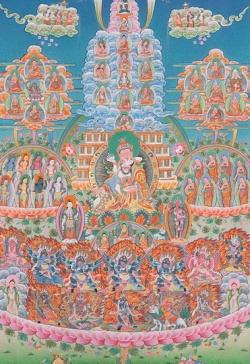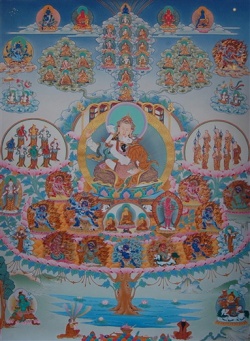Difference between revisions of "The Refuge Tree"
(Created page with "thumb|250px| <poem> Each denomination, and even each lineage has a "geneological" chart that is known as the Refuge Tree. In it are repres...") |
|||
| Line 14: | Line 14: | ||
Similar in function to a Refuge Tree is what is known as the Field of Merit. | Similar in function to a Refuge Tree is what is known as the Field of Merit. | ||
| + | |||
| + | When Guru Rinpoche is at the center surrounded by deities and lamas, it can be a Konchok Chi Du tree. Konchok Chi Du is the name of a cycle of tantric practices that centres on Guru Rinpoche as the embodiment of the three jewels and roots. Its origin is a complete cycle of terma of Jetsun Nyingpo's and is one of the Northern Treasures of the Nyingma. | ||
| + | |||
| + | Konchok means "Supremely Rare" and when part of the expression Konchok Sum, it means The Three Jewels (Buddha, Dharma, and Sangha; and by extension, the Three Roots: Lama, Yidam, Protector.) | ||
</poem> | </poem> | ||
{{R}} | {{R}} | ||
Revision as of 16:40, 27 May 2013
Each denomination, and even each lineage has a "geneological" chart that is known as the Refuge Tree. In it are represented the founders and teachers in an arrangement that symbolizes the interconnectedness of the various groups.
As the Dalai Lama explains:
"Within the context of Tibetan Buddhism, the importance of lineage extends far beyond the ordinary sense of a particular line of inheritance or descent. Lineage is a sacred trust through which the integrity of Buddha's teachings is preserved intact as it is transmitted from one generation to the next. The vital link through which the spiritual tradition is nourished and maintained is the profound connection between an enlightened master and perfectly devoted disciple. The master-disciple relationship is considered extremely sacred by all the major schools of Tibetan Buddhism."
Practitioners use the Refuge Tree and /or a Field of Merit to visualize their lineage and chain of devotion, of merit and of obligation and protection.
It is depicted as a wondrous tree with several branches. By means of artistic convention, even the branches at the back of the tree are indicated. In the sky overhead with the sun and the moon is usually found the samboghakaya form of the founding buddha, and the bodhisattvas and dakinis associated with the lineage. On the upper branches are the founding human members and closer to the ground, we see the 20th-century masters. Living teachers are not depicted.
At the foot of the great tree are the dharma protectors and the various kinds of offerings. At the bottom of the scroll or poster are often representations of those who are taking refuge in the particular tree. Practitioners can imagine themselves there, and also, they can imagine a forest of similar trees belonging to the other lineages knowing that the Buddha, Shakyamuni, appears above all of them.
Similar in function to a Refuge Tree is what is known as the Field of Merit.
When Guru Rinpoche is at the center surrounded by deities and lamas, it can be a Konchok Chi Du tree. Konchok Chi Du is the name of a cycle of tantric practices that centres on Guru Rinpoche as the embodiment of the three jewels and roots. Its origin is a complete cycle of terma of Jetsun Nyingpo's and is one of the Northern Treasures of the Nyingma.
Konchok means "Supremely Rare" and when part of the expression Konchok Sum, it means The Three Jewels (Buddha, Dharma, and Sangha; and by extension, the Three Roots: Lama, Yidam, Protector.)

